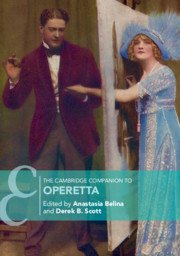Book contents
- The Cambridge Companion to Operetta
- Cambridge Companions to Music
- The Cambridge Companion to Operetta
- Copyright page
- Contents
- Illustrations
- Tables
- Music Examples
- Notes on Contributors
- Chronology, 1855–1950
- Introduction
- Part I Early Centres of Operetta
- Part II The Global Expansion of Operetta
- 6 Going Global: The International Spread of Viennese Silver-Age Operetta
- 7 Spain and Zarzuela
- 8 Camping along the American Operetta Divide (on the Road to the Musical Play)
- 9 Operetta in Russia and the USSR
- 10 Operetta in the Nordic Countries (1850–1970)
- 11 Operetta in Greece
- Part III Operetta since 1900
- Select Bibliography
- Index
- References
7 - Spain and Zarzuela
from Part II - The Global Expansion of Operetta
Published online by Cambridge University Press: 14 November 2019
- The Cambridge Companion to Operetta
- Cambridge Companions to Music
- The Cambridge Companion to Operetta
- Copyright page
- Contents
- Illustrations
- Tables
- Music Examples
- Notes on Contributors
- Chronology, 1855–1950
- Introduction
- Part I Early Centres of Operetta
- Part II The Global Expansion of Operetta
- 6 Going Global: The International Spread of Viennese Silver-Age Operetta
- 7 Spain and Zarzuela
- 8 Camping along the American Operetta Divide (on the Road to the Musical Play)
- 9 Operetta in Russia and the USSR
- 10 Operetta in the Nordic Countries (1850–1970)
- 11 Operetta in Greece
- Part III Operetta since 1900
- Select Bibliography
- Index
- References
Summary
What is zarzuela? What is its relation to operetta? If the first question can only be addressed in general terms, the second requires a more complex answer. The development of Spanish-language music theatre has been shaped over four centuries by dialogue with opera on one side and operetta on the other. The influence of external operetta movements on zarzuela ranges from Parisian opéra comique and Offenbach’s opéra bouffe, through the English musical plays of Jones and Monckton to the Viennese ‘silver age’. All these nourished the Spanish genre while (as Nietzsche recognized) extending the concept of operetta. After examining classic género chico works such as Federico Chueca’s La Gran Vía and Ruperto Chapí’s La revoltosa, Christopher Webber highlights the period between 1910 and the early 1920s. In those years lavish opereta español was the fashion in Madrid, notably Pablo Luna’s key work El asombro de Damasco, written with London tastes in mind. A brief coda surveys developments after the Spanish Civil War, notably Pablo Sorozábal’s Black, el payaso. This daring 1942 satire on Francoist rule, masquerading as a homage to Emmerich Kálmán, was one the last works to yoke the societal concerns of romantic zarzuela with operetta.
- Type
- Chapter
- Information
- The Cambridge Companion to Operetta , pp. 103 - 119Publisher: Cambridge University PressPrint publication year: 2019

